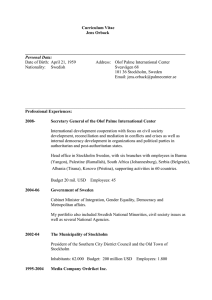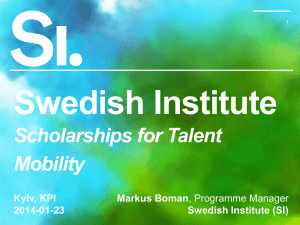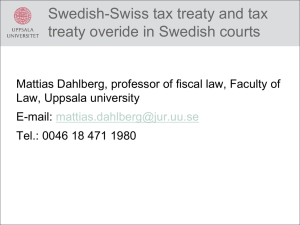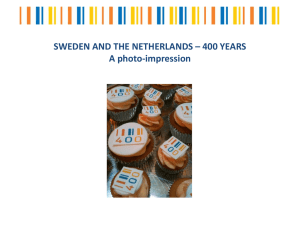crime and sociaL criticism
advertisement
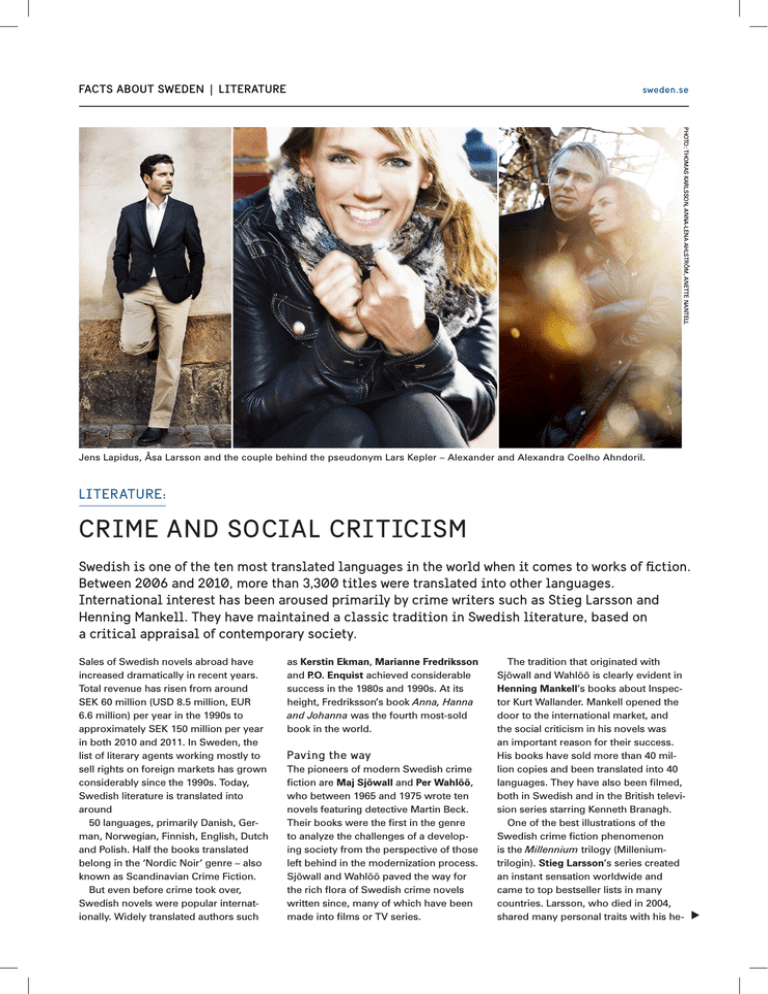
facts about sweden | Literature sweden.se Photo: Thomas Karlsson, Anna-Lena Ahlström, Anette Nantell Jens Lapidus, Åsa Larsson and the couple behind the pseudonym Lars Kepler – Alexander and Alexandra Coelho Ahndoril. Literature: Crime and social criticism Swedish is one of the ten most translated languages in the world when it comes to works of fiction. Between 2006 and 2010, more than 3,300 titles were translated into other languages. International interest has been aroused primarily by crime writers such as Stieg Larsson and Henning Mankell. They have maintained a classic tradition in Swedish literature, based on a critical appraisal of contemporary society. Sales of Swedish novels abroad have increased dramatically in recent years. Total revenue has risen from around SEK 60 million (USD 8.5 million, EUR 6.6 million) per year in the 1990s to ­approximately SEK 150 million per year in both 2010 and 2011. In Sweden, the list of literary agents working mostly to sell rights on foreign markets has grown considerably since the 1990s. Today, Swedish literature is translated into around 50 languages, primarily Danish, German, Norwegian, Finnish, English, Dutch and Polish. Half the books translated belong in the ‘Nordic Noir’ genre – also known as Scandinavian Crime Fiction. But even before crime took over, Swedish novels were popular internationally. Widely translated authors such as Kerstin Ekman, Marianne Fredriksson and P.O. Enquist achieved considerable success in the 1980s and 1990s. At its height, Fredriksson’s book Anna, Hanna and Johanna was the fourth most-sold book in the world. Paving the way The pioneers of modern Swedish crime fiction are Maj Sjöwall and Per Wahlöö, who between 1965 and 1975 wrote ten novels featuring detective Martin Beck. Their books were the first in the genre to analyze the challenges of a developing society from the perspective of those left behind in the modernization process. Sjöwall and Wahlöö paved the way for the rich flora of Swedish crime novels written since, many of which have been made into films or TV series. The tradition that originated with Sjöwall and Wahlöö is clearly evident in Henning Mankell’s books about Inspector Kurt Wallander. Mankell opened the door to the international market, and the social criticism in his novels was an important reason for their success. His books have sold more than 40 million copies and been translated into 40 languages. They have also been filmed, both in Swedish and in the British television series starring Kenneth Branagh. One of the best illustrations of the Swedish crime fiction phenomenon is the Millennium trilogy (Milleniumtrilogin). Stieg Larsson’s series created an instant sensation worldwide and came to top bestseller lists in many countries. Larsson, who died in 2004, shared many personal traits with his he- facts about sweden | Literature sweden.se Photo: Dan Hansson/SVD/Scanpix Did you know? Popular libraries Sweden has a robust library culture, with some 1,300 libraries scattered around the country. Ninety-eight per cent of all Swedes have visited a library at some point. On an average day, the average Swede spends 21 minutes reading a book, 38 minutes reading a newspaper or magazine, and 68 minutes on the internet. Successful Swedish fantasy The Circle (Cirkeln) is a Swedish fantasy book from 2011, the first in a trilogy about teenage witches written by Mats Strandberg and Sara Bergmark Elfgren. It has proved highly popular among adults as well, despite having been marketed as a book for young readers. The book has been translated into English and is scheduled for translation into 20 more languages. Literary tourism Sweden has a wealth of sites to attract literary tourists. They can for instance join the Millennium Tour, which points out key locations and settings described in the novels by Stieg Larsson. The Wallander tours in Ystad in the south of Sweden are also popular. Photo: Christine Olsson Interest in ebooks is growing in Sweden. ebooks Sales of ebooks in Sweden doubled between 2010 and 2011 but still represent only a fraction of publishers’ annual turnover. The largest share of ebooks is bought by public libraries. Each year, the libraries lend some 20,000 ebooks and 1,400 audiobooks to borrowers, via Elib, the Scandinavian distributor that dominates the Swedish ebook market. 2| The author couple Sara Bergmark Elfgren and Mats Strandberg’s first book about a group of teenage witches is scheduled for translation into more than 20 languages. ro, Mikael Blomkvist, including being an investigative political reporter. The Millennium trilogy has been filmed twice, once by Sweden and once by Hollywood. Leif G.W. Persson and Liza Marklund also weave social criticism into their books. Persson, a criminologist, is one of Sweden’s most established crime writers. Many of his cases touch upon the 1986 murder of Swedish Prime Minister Olof Palme, and a frequent theme is incompetence and corruption among police officers, civil servants and politicians. Marklund made her debut in 1998 with Deadline (Sprängaren), the first book in a series of nine about the investigative reporter Annika Bengtzon. Marklund has inspired other women to write crime fiction and their number has increased dramatically since her debut. Between 1991 and 1997, there were only two crime novels written by women released. In 2012, there were over 20. One of the most successful women crime writers is Camilla Läckberg. Since her debut in 2003 with The Ice Princess (Isprinsessan), she has sold 5 million books in 30 countries. Other international successes Other writers who have found success abroad are Håkan Nesser and Arne Dahl. Nesser’s The Mind’s Eye (Det grovmaskiga nätet), published in 1993, was the first in the Maardam series, ten books about Inspector Van Veeteren. Arne Dahl is a pseudonym for Jan Arnald. Dahl has written a series of eleven novels about the A-group, a special unit in the Swedish police dealing with international crime. The series has been translated in 20 languages and five of the books have been filmed. Åke Edwardson’s novels about Inspector Erik Winter have been translated into some 20 languages, and several have become movies. Åsa Larsson made her mark in the world of crime fiction starting with her debut novel Sun Storm (Solstorm), the first in a series of books about lawyer Rebecka Martinsson. Marie Jungstedt first became known in 2003 with Unseen (Den du inte ser). Since then she has written ten books about Police Inspector Anders Knutas. Her novels have been translated into more than 15 languages, and also given rise to a German TV series. Karin Alvtegen’s five books have established her reputation worldwide, with translation rights sold in 30 countries. Her second book, Missing (Saknad), has been made into a British TV miniseries. Jens Lapidus has been tremendously successful with three novels set in the criminal underworld and in a fast-paced, young and hip Stockholm. The novels have been sold to 30 countries and have also generated a trilogy of films. Under the pseudonym of Lars Kepler, Stockholm couple Alexander and Alex­ andra Coelho Ahndoril have written grim, nightmarish thrillers. The first, The Hypnotist (Hypnotisören), was released in 2009. It has been sold to 23 countries and has also been made into a movie. n facts about sweden | Literature sweden.se Photo: Skånereportage Must-read Swedish books April Witch (Aprilhäxan) by Majgull Axelsson, 1997 The Serious Game (Den allvarsamma leken) by Hjalmar Söderberg, 1912 Gösta Berling’s Saga (Gösta Berlings saga) by Selma Lagerlöf, 1891 The Hundred-Year-Old Man Who Climbed Out of the Window and Disappeared (Hundraåringen som klev ut genom fönstret och försvann) by Jonas Jonasson, 2009 Working-class author Vilhelm Moberg’s novels about Swedes emigrating to the US was made into a movie in 1971. The People of Hemsö (Hemsöborna) by August Strindberg, 1887 Fiction steeped in tradition Let the Right One In Swedish writers have long been good storytellers. Authors such as August Strindberg and Selma Lagerlöf have left an indelible mark. (Låt den rätte komma in) by Johan Ajvide Lindqvist, 2004 Simon and the Oaks (Simon och ekarna) by Marianne Fredriksson, 1985 Let Me Sing You Gentle Songs (Nu vill jag sjunga dig milda sånger) by Linda Olsson, 2006 The Road (Vägen till Klockrike) by Harry Martinson, 1948 Popular Music from Vittula (Populärmusik från Vittula) by Mikael Niemi, 2000 Photo: Robin Haldert Mikael Niemi. Among the classic writers of the 20th century best known for their accounts of working-class life are Eyvind Johnson, Ivar Lo-Johansson, Vilhelm Moberg, Artur Lundkvist, Harry Martinson, Jan Fridegård, Moa Martinson and Elin Wägner. Moberg was widely acclaimed for The Emigrants (Utvandrarna), a series of novels about Swedes who migrated to the US in the mid-19th century. Wägner’s themes include women’s rights, women’s suffrage, and peace and environment issues, and paved the way for Swedish feminist fiction. In the 1960s, political activism increased in Sweden and documentary novels became popular, with P.O. Enquist and Sara Lidman the leading names. Two other prominent writers of social critique are P.C. Jersild and Jan Guillou. Jersild tends to write idea-based novels, such as House of Babel (Babels hus), in which he criticizes industrial-scale hospital care. His latest book, Ypsilon, was published in 2012. Guillou, who is also a journalist, is a controversial polemicist. As an author he is best known for his books about Swedish agent Carl Ham- ilton, and his historical novels about the Knight Templar Arn Magnusson. Both series have been filmed. Kerstin Ekman penned a series of novels about working-class women, of which the first part, Witches’ Rings (Häxringarna) came out in 1974. Among her other leading works are Blackwater (Händelser vid vatten) and a trilogy, The Wolfskin (Vargskinnet), about social development in northern Sweden. Ekmanwas elected a member of the Swedish Academy in 1978, but left in 1989 in protest at its failure to support Salman Rushdie over the Satanic Verses controversy. Torgny Lindgren is a member of the Swedish Academy and his books have been translated into 30 languages. His breakthrough came in 1982 with The Way of a Serpent (Ormens väg på hälleberget), which describes life in Västerbotten, in northern Sweden, at the end of the 19th century. Journalist and author Majgull Axelsson has written numerous documentary books about the developing world. Her first novel, Far away from Nifelheim (Långt borta från Nifelheim), came out in 1994. 3| facts about sweden | Literature The Swedish Academy An independent cultural institution founded in 1786 by King Gustav III. Its official task is to advance the Swedish language and Swedish literature. The Nobel Prize The Nobel Prize is the legacy of Sweden’s Alfred Nobel (1833–1896). In his will, he delegated the task of selecting the Literature prizewinners to the Swedish Academy. The first Nobel Prizes were awarded in 1901. Swedish poet Tomas Tranströmer was awarded the Nobel Prize in Literature in 2011. Other Swedish writers who have won the Nobel Prize are Selma Lagerlöf, Verner von Heidenstam, Erik Axel Karlfeldt, Pär Lagerkvist, Nelly Sachs (German-Swedish), Eyvind Johnson and Harry Martinson. The August Prize One of Sweden’s most celebrated and prestigious literary prizes, it is awarded each November in three categories: Best Swedish Fiction Book of the Year, Best Swedish Non-Fiction Book of the Year, and Best Swedish Children’s Book of the Year. The Swedish Crime Writers’ Academy Established in 1971 to promote the writing of crime fiction, the academy awards several prizes, including one for the Best Swedish Crime Novel. Gellert Tamas is a Swedish journalist and author of several works of nonfiction, the best-known being The Laser Man – A Story About Sweden (Lasermannen – En berättelse om Sverige). It tells of John Ausonius, a convicted racist murderer who shot at eleven people with immigrant backgrounds, killing one, in the early 1990s. Katarina Mazetti has written books in different genres. Several of them have been filmed and many have been translated into numerous languages. Her book Benny & Shrimp (Grabben i graven bredvid), from 1999, is about an odd love affair between an intellectual librarian and a simple farmer. In France, the book has sold 450,000 copies and is currently being produced as a play. Susanna Alakoski was born in Finland but grew up in Skåne, southern Sweden. Her debut novel, Beyond (Svinalängorna), was made into both a film and a play, and has sold over half a million copies. It describes life in southern Sweden in the 1960s, in a culture where alcoholism was rife. Carl-Johan Vallgren has won a number of awards for his books, which have been sold to 25 countries. Horrific Sufferings of the Mind-Reading Monster Hercule Barefoot (Den vidunderliga kärlekens historia) is the novel that has achieved the greatest success interna- Photo: Sandra Qvist/Scanpix Learn more sweden.se Jonas Hassen Khemiri. tionally. Jonas Gardell has published 18 books, the most recent being Torka aldrig tårar utan handskar: 1. Kärleken. The first of a trilogy of books, it describes when AIDS came to Stockholm in the 1980s. Jonas Hassen Khemiri made his debut in 2003 with the book One Eye Red (Ett öga rött) about Halim, a teenager with Moroccan parents, growing up in Stockholm. Written in ‘immigrant patois’, it deals with such problems as ethnicity, roots and the importance of language for a person’s identity. n Useful links augustpriset.se The August Prize biblioteksforeningen.se Svenska biblioteksföreningen: The Swedish Library Association The Göteborg book fair The annual book fair in Göteborg (Gothenburg) is the biggest meeting place in the Nordic region for both the book trade and the library sector. It takes place in September and in recent years has attracted some 100,000 visitors each time. bokmassan.se Göteborgs bokmässa: The Göteborg Book Fair deckarakademin.se Svenska Deckarakademin: The Swedish Crime Writers’ Academy forlaggare.se Svenska förläggarföreningen: The Swedish Publishers’ Association kulturradet.se Kulturrådet: The National Council for Cultural Affairs nobelprize.org Official Website of the Nobel Prize svenskaakademien.se Svenska Akademien: The Swedish Academy Copyright: Published by the Swedish Institute. February 2013 FS 22. All content is protected by Swedish copyright law. The text may be reproduced, transmitted, displayed, published or broadcast in any media with reference to sweden.se. However, no photographs or illustrations may be used. The Swedish Institute (SI) is a public agency that promotes interest and confidence in Sweden around the world. SI seeks to establish co-operation and lasting relations with other countries through strategic communication and exchange in the fields of culture, education, science and business. Further information about Sweden: sweden.se, the Swedish embassy or consulate in your country, or the Swedish Institute, Box 7434, SE-103 91 Stockholm, Sweden. Phone: +46 8 453 78 00; e-mail: si@si.se www.si.se www.swedenbookshop.com www.swedenabroad.com
